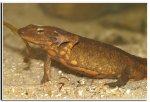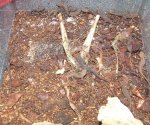First off all seems like you had a good breeding there Louise, they do seem do to well (nice filled bellies ) and hope you can continue to rear them further. Yes indeed that one on the right clearly has a more pale colroation then the rest. I guess we'll just have to see how this evolves Louise. In tylototriton shanjing and even in ambystoma opacum I formerly also had 2 types of larvae : darker ones and more pale colored ones. At then end all of them become the usual coloration when going on land. In hynobius retadatus I have pale colored larvae (even white ones) and these have retained their coloration. So let's see what these warted newts become to be as they age and whatever they end up to be .. Normally all your juveniles will get a lighter coloration as they go back into the water, I'm intruiged to see what the differences will be by then. But I'm sure they 'll be welcomed whatever they become anyway , no ?





